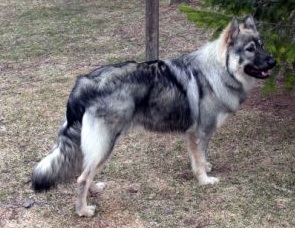Also known as the Alsatian Shepalute, the American Alsatian was registered in the United States with the North American Shepalute Club (now called the American Alsatian Club) back in 1988. Creating this breed meant mixing the following purebred breeds: Alaskan Malamute, Anatolian Shepard, English Mastiff, German Shepard, and Great Pyrenees. Only those pups which exhibited the desired traits, including the necessary traits of a companion dog, were chosen for the breeding program.
It wasn't until the year 2000 that the first American Alsatian was truly introduced to the public. It took this long for all dogs of the breed to exhibit the breed standards set out by Lois Denny, the founder of the breed, back in 1987. Today, they are rare but can still be found across North America.
The American Alsatian is a large dog, weighing as much as 120 pounds. Females are slightly smaller than males. The ears of this breed stand naturally erect and the eyes, which range from yellow to light brown, are slightly almond shaped. The chest is deep and the body is longer than the tail. The tail itself is tipped with black and hangs down to the pasterns.
The coat of the American Alsatian is medium in length and thick. Though silver sable is the more desirable color, other acceptable colors include gold, black sable, or cream. White or black sable markings are rare but highly prized. Touching this luscious coat is much like touching a bear skin rug. Unfortunately, this coat does tend to mat, especially around the ears and on the backs of the legs. Regular brushing takes care of this problem. The hairs of this dog shed dirt easily and do not retain odor, making the American Alsatian a clean dog. They do shed, however, especially in the spring and fall. A stiff brush can be used to remove the large clumps of hair before they fall to the floor, but you have to be diligent about this.
Bred to be a companion dog, the American Alsatian is excellent with young children and small animals. This breed may seem uninterested in strangers, but they are rarely aggressive or fearful. They are sweet and intelligent, making them easy to train. This is not a playful breed, but the American Alsatian with play if sufficiently encouraged. Not a fan of too much activity, this breed requires sufficient exercise to keep it in decent shape. This calm dog isn't easily ruffled and tends to move slowly and stay close to home. They bond quickly to their family and are both protective and loving.
This dog can live just about anywhere, from apartment to farm. They tolerate some cold well, but should be brought inside if the temperature dips much below freezing. Like many other thick-coated breeds, they don't like the heat. If outdoors in the height of summer, be sure to provide plenty of cool water and shade.
As a breed, the American Alsatian is fairly healthy. There was a single case of epilepsy in 2009, but this doesn't seem to be specific to the breed. There were also a couple of cases of severe arthritis in 2003, but not in any higher occurrence than any other large dog breed. All in all, the American Alsatian is healthy and hardy, living an average of twelve to fourteen years.
If you're looking for a companion dog for your family, the American Alsatian might be for you. They are quiet and calm and deal well with both people and animals. They have a low prey drive, however, making them almost useless for protection and they are not really working dogs. They would make a better therapy dog than a farm dog, and prefer to live with a large family.

No comments:
Post a Comment